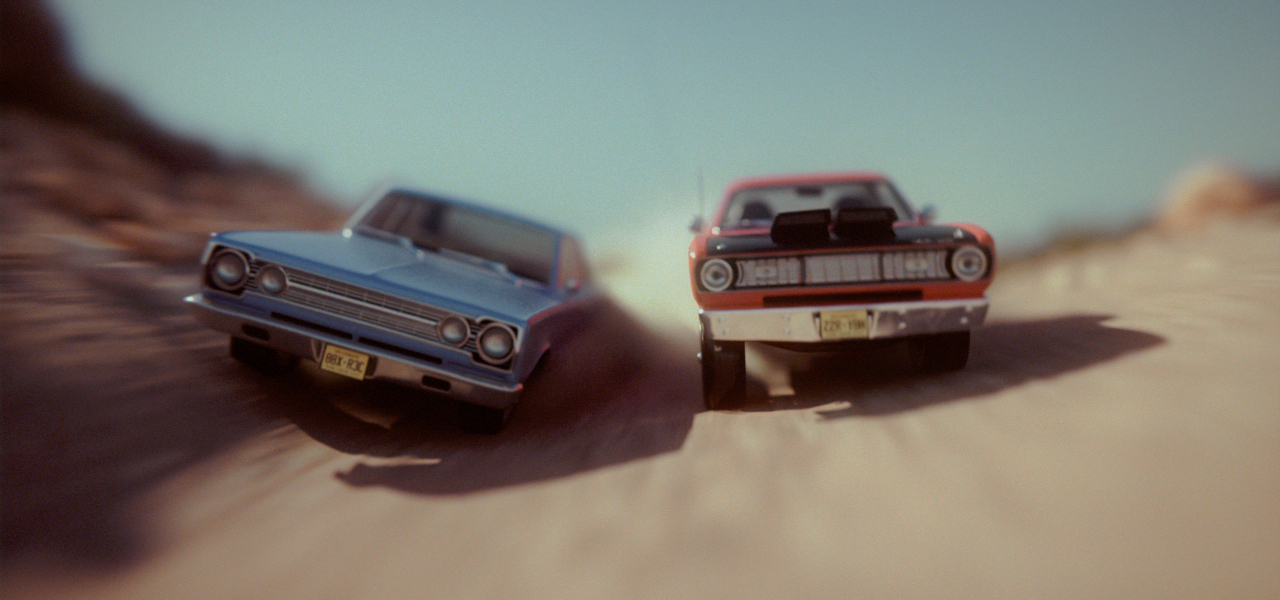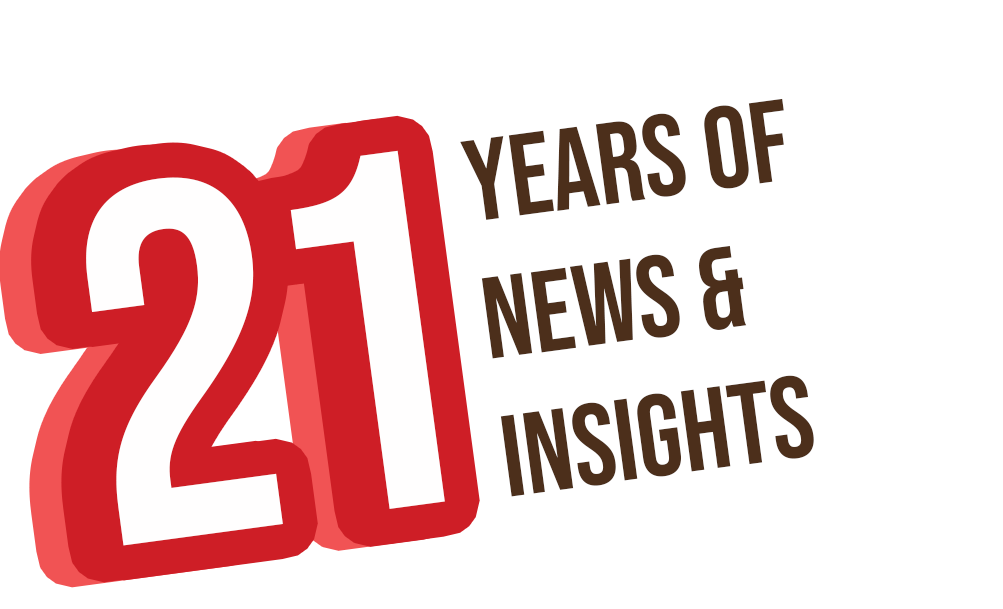

Hot Wheels: Creating The Toy-Car Titles For JJ Abrams and LaToya Morgan’s Crime Thriller Series ‘Duster’
Tiny racing cars have been tearing up the desert in the countryside of Burgundy, central France, about 100 kilometers south of Paris.
The imagery––title sequence for HBO Max’s crime show Duster, starring Josh Holloway as a sardonic getaway driver in a red 1972 Plymouth Duster––resembled a boy’s dream of 1/64-scale die-cast Hot Wheels toys careening through miniature Americana landscapes.
Created mostly in Blender at Meat Dept., a collective of digital artists led by co-directors Kevin Van Der Meiren and David Nicolas, the titles were the first Hollywood production for the duo, whose output, since 2016, has included offbeat and inventive shorts and music videos, such as the Sundance sci-fi comedy Black Holes, an episode of Netflix’s Love, Death + Robots entitled Automated Customer Service, and psychedelic shorts for French techno-metal impresario Igorrr.
Duster sprang from correspondence with the founder of the series’ production company, Bad Robot. “J.J. Abrams reached out to us a while back,” recalled Van Der Meiren. “He’d seen a music video of ours and Black Holes, and he loved their style. I think the idea of producing animation was beginning to grow at Bad Robot, so we started talking about a collaboration.”
Abrams sensed his upcoming series’ anarchic vibe, conceived as a tribute to the 1970s car-chase movies, would be a match with the studio’s imaginative visual aesthetic. Van Der Meiren and Nicolas gave Cartoon Brew the skinny and shared a behind-the-scenes video, seen below.
Cartoon Brew: What was J.J.’s pitch?
Kevin Van Der Meiren: There was no pitch! J.J. and [series co-creator] LaToya said, “We have this new show coming up, and we want you to make the title design.” They gave us a lot of room. They talked a little bit about the style and the vibe of the show, and said, “Don’t be scared of being yourself. Go for it.”
David Nicolas: We did scare him at the end [laughs].
Van Der Meiren: Yeah, we went a bit too far sometimes. But it was the first time we’ve worked with an American producer who came to us from the right reasons. He didn’t want to put us in a box. A title sequence works as a decompression chamber for a series; it’s important to set the right tone. J.J. and LaToya came to us because they wanted something different, to push the bar. But at some point, the sequence became so surreal and so abstract that we realized, “Oh, okay…” We were looking for a balance. J.J. and LaToya helped us adjust the thermostat level.
Did you have Hot Wheels toys growing up in France?
Nicolas: Of course! But they were called Majorette in France. They were the same as Hot Wheels, but with French and European cars. Hot Wheels came later in France.
How did that evolve from your pitch?
Van Der Meiren: We had two ideas. Our first idea was like a ’70s magazine look. We’d enter into the magazine, with very saturated colors and a 70s comic-book style. And then, we pitched Hot Wheels, with the feel of a miniature, as a really cool way to have fun to make the opening a little crazy, without being realistic, or rather, by creating a shift with reality and live-action. Hyper-real animation is not our thing.
Nicolas: But it still had a degree of realism. We had a friend who asked if we still had the model cars. Where did we shoot them? Where was the studio?
There’s a beautiful miniature feel to the vehicles. Did you study toy cars?
Van Der Meiren: We did. We had the toys that we have here at home, and we gathered some pictures of the actual cars from the show. They were shooting while we were animating, so they sent us a lot of photographs of the cars on set. All the cars you see in the title sequence are cars in the show.
Nicolas: We quickly made the choice not to represent human figures in the sequence, and to treat the vehicles as characters. As we progressed through the eight episodes, we introduced new cars, which represented new characters in the show.
To clarify: everything is CG?
Van Der Meiren: Yes. To make the models, we studied the scale effects of details, like the exaggerated thickness of the paint. Even underneath the cars, which we rarely reveal in the sequence, the underside is like a very simple plastic mold, like Hot Wheels. We went into detail in trying to make them look as realistically toy-like as possible.
Hot Wheels cars’ suspension is a needle between the two hard plastic wheels. Did you rig your CG Duster model like a toy?
Nicolas: No, because we wanted to add the physics of a real car to the Hot Wheels look. It’s a subtle mix. You feel that in the crashes and in the stunts, the Duster moves like a real car.
Van Der Meiren: We played with that ambiguity, so the viewer isn’t sure how it’s done. David and I like to lose people in between, so it’s not clearly one thing or another. We’d like to navigate between two worlds in the Uncanny Valley.
The shallow depth-of-field has the feel of a ’tilt-shift’ lens, creating areas of selective focus. How did you do that?
Van Der Meiren: We looked into ways to make a ‘real’ tilt-shift effect in CG, where you offset the digital lens to create a world with a weird depth of field. But the thing is, if you do that, you mess everything up. Your passes don’t match anymore. If you want to do post-effects, it’s baked in, and you can’t do anything.
Nicolas: To composite a shot with a second car in the background, tilt-shift totally messed that up. So, we had to cheat.
Van Der Meiren: Yeah. In 3d we used very strong depths of field, like macro lenses. But we created the macro lens in 3d, and then we did a post-effect tilt-shift in Nuke. Nuke is cool because it’s like a ‘two-and-a-half-d’ software––you make your composite in 3d space. So our compositor, Fabien Feintrenie, who is an old friend who’s been working with us forever, made the tilt/shift in 3d, in compositing. And it worked pretty well.
How did you build your desert environments?
Nicolas: It was mostly modeling and instancing. For one or two shots, like the Grand Canyon view from a helicopter, we used some real Google data. That was more to find the real vibe of the desert. We didn’t use it raw. It was more a reference, and then we painted onto that reference. We resculpted it to make it look more roughly made. Then we dressed in plants, rocks, et cetera, using the Geo-Scatter add-on for Blender.
The effects animation sometimes feels very real, like smoke coming off the tires, but there’s also a funny moment with an explosion that looks like Gerry Anderson’s Thunderbirds.
Nicolas: [LAUGHING] Thunderbirds was our first reference! We are fans. My brother Laurent and I grew up with that show, and we shared that obsession with J.J.
Did you shoot real pyro?
Nicolas: No, it’s simulated in Houdini.
Van Der Meiren: The idea was to not have a real explosion. We wanted the effect to feel ‘wrong,’ with a huge flame, so the scale was off.
Nicolas: Just like Thunderbirds!
There’s a lovely attention to detail, too, in the evolving nature of the titles across the eight-episode series. Can you explain the idea behind that?
Van Der Meiren: The titles evolve from Episode 1 to Episode 8. Each time, we included Easter eggs specific to each episode. Our idea was to inject surrealism into those evolutions, so going from Episode 1 to Episode 8, the sequence becomes more crazy and surreal.
So, each added detail is pertinent to the narrative?
Van Der Meiren: Yes. Each time, it’s either an Easter egg or a clue for the investigation. At first, the plan was to make just one title sequence for the show, but we couldn’t give away too many clues at the start of the series. That’s why we decided to make the titles evolve. One episode at a time, we added little pieces. We added blue suede shoes [hanging from a telephone wire], and in the next episode, there’s a Rolodex with information inside that is important for that episode. Later, there’s a wonderful Howard Hughes Aero-Mobile car that appears in the show.
Nicolas: For that episode, we added a truck hauling a big Dinky toy box on its container with a big toy Aero-Mobile car inside as we pass by.
Did you have to re-render all your animation for each new version?
Van Der Meiren: That was done in editing. The Easter eggs add up, episode after episode. The titles of Episode 1 and Episode 8 had nothing in common. We replaced some shots to make it work in the editing. We rendered most of the shots only once, with ‘handles’ to allow room in editing. It was pretty simple.
How many were on your team, and what were your technical resources?
Van Der Meiren: The core team was four of us. Denis Parrot, Lino Grandi, David, and I. Then, David’s brother Laurent helped us on the storyboard, Angelo Caramanica on animation, Luca Giarrettino on modeling, Anthony Maalouf on VFX, Mario Hawatt on rendering, and Fabien on compositing.
Nicolas: Most of the time, it was just Kevin and me working in Blender. That’s our main animation tool. We use Cycles, the Blender render engine, plus for a few sequences we rendered with Octane. Mostly, it’s the two of us.
Production: Bad Robot, HBO Max, Warner Bros. Television
Show creators: J.J. Abrams, LaToya Morgan
Studio: Meat Dept.
Director: Meat Dept. (David Nicolas, Kevin Van Der Meiren)
Storyboard: Laurent Nicolas
CG artists: David Nicolas, Kevin Van Der Meiren, Denis Parrot, Lino Grandi
Animator: Angelo Caramanica
Visual effects artist: Anthony Maalouf
Modeling: Luca Giarrettino
Rendering: Mario Hawatt
Compositor: Fabien Feintrenie
Editor: Kevin Van Der Meiren
Music: J.J. Abrams
Tools: Blender, Cycles, Octane, Houdini, Nuke, After Effects, Photoshop, DaVinci Resolve.

.png)